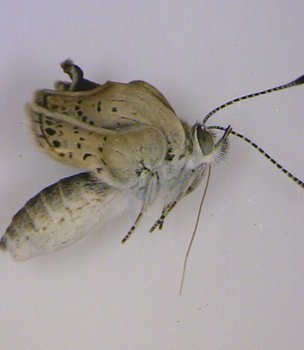日本科學(xué)家研究發(fā)現(xiàn),福島核事故之后,由于受到放射性物質(zhì)的影響,日本的蝴蝶品種出現(xiàn)了翅膀變小、眼睛發(fā)育不規(guī)則等明顯的變異現(xiàn)象。2011年3月福島核事故后兩個(gè)月后,研究人員從日本10個(gè)不同地區(qū)采集了144只成年酢漿灰蝶樣本進(jìn)行研究。研究發(fā)現(xiàn),核輻射越嚴(yán)重地區(qū)的蝴蝶,其翅膀和眼睛的變異現(xiàn)象越明顯。研究組的一位研究人員表示,之前一直都認(rèn)為昆蟲的抗輻射能力很強(qiáng),因此該研究得出的結(jié)論有些出人意料。6個(gè)月之后,研究人員再次從上述10個(gè)地區(qū)采集蝴蝶樣本,結(jié)果發(fā)現(xiàn)福島地區(qū)的蝴蝶變異幾率變成了原來的兩倍。研究人員指出,變異幾率上升的原因一部分是因?yàn)閿z入受輻射的食物,另一個(gè)原因就是基因遺傳。受到輻射初期沒有表現(xiàn)出變異癥狀的蝴蝶,它們的下一代可能就會(huì)表現(xiàn)出明顯的變異癥狀了。該研究結(jié)果表明,雖然福島地區(qū)的輻射殘留物質(zhì)已經(jīng)明顯減少,但對(duì)動(dòng)物和環(huán)境的輻射影響仍然存在。

 |
|
The study found that mutation rates were much higher among butterfly collected near Fukushima |
Exposure to radioactive material released into the environment has caused mutations in butterflies found in Japan, a study suggests.
Scientists found an increase in leg, antennae and wing shape mutations among butterflies collected following the 2011 Fukushima accident.
The link between the mutations and the radioactive material was shown by laboratory experiments, they report.
The work has been published in the journal Scientific Reports.
Two months after the Fukushima Daiichi nuclear power plant accident in March 2011, a team of Japanese researchers collected 144 adult pale grass blue (Zizeeria maha) butterflies from 10 locations in Japan, including the Fukushima area.
When the accident occurred, the adult butterflies would have been overwintering as larvae.
Unexpected results
By comparing mutations found on the butterflies collected from the different sites, the team found that areas with greater amounts of radiation in the environment were home to butterflies with much smaller wings and irregularly developed eyes.
"It has been believed that insects are very resistant to radiation," said lead researcher Joji Otaki from the University of the Ryukyus, Okinawa.
"In that sense, our results were unexpected," he told BBC News.
The Japanese researchers have been studying the species for more than a decade Prof Otaki's team then bred these butterflies within labs 1,750km (1,090 miles) away from the accident, where artificial radiation could hardly be detected.
It was by breeding these butterflies that they began noticing a suite of abnormalities that hadn't been seen in the previous generation - that collected from Fukushima - such as malformed antennae, which the insects use to explore their environment and seek out mates.
Six months later, they again collected adults from the 10 sites and found that butterflies from the Fukushima area showed a mutation rate more than double that of those found sooner after the accident.
The team concluded that this higher rate of mutation came from eating contaminated food, but also from mutations of the parents' genetic material that was passed on to the next generation, even though these mutations were not evident in the previous generations' adult butterflies.
The team of researchers have been studying that particular species butterfly for more than 10 years.
They were considering using the species as an "environmental indicator" before the Fukushima accident, as previous work had shown it is very sensitive to environmental changes.
"We had reported the real-time field evolution of colour patterns of this butterfly in response to global warming before, and [because] this butterfly is found in artificial environments - such as gardens and public parks - this butterfly can monitor human environments," Prof Otaki said.
But the findings from their new research show that the radionuclides released from the accident were still affecting the development of the animals, even after the residual radiation in the environment had decayed.
"This study is important and overwhelming in its implications for both the human and biological communities living in Fukushima," explained University of South Carolina biologist Tim Mousseau, who studies the impacts of radiation on animals and plants in Chernobyl and Fukushima, but was not involved in this research.
"These observations of mutations and morphological abnormalities can only be explained as having resulted from exposure to radioactive contaminants," Dr Mousseau told BBC News.
The findings from the Japanese team are consistent with previous studies that have indicated birds and butterflies are important tools to investigate the long-term impacts of radioactive contaminants in the environment.
相關(guān)閱讀
調(diào)查報(bào)告稱福島核事故為“人為災(zāi)難”
日本數(shù)萬民眾集會(huì) 反對(duì)使用核能
(Agencies)

(中國日?qǐng)?bào)網(wǎng)英語點(diǎn)津 Helen 編輯)
